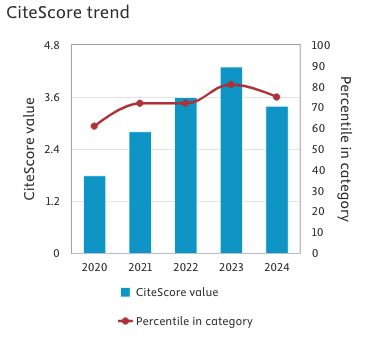Pediatric bronchiolitis obliterans after Stevens-Johnson syndrome: A multidisciplinary case report
Keywords:
bronchiolitis obliterans, Stevens-Johnson Syndrome, pediatrics, case report, diagnosisAbstract
Introduction: Bronchiolitis obliterans (BO) is a rare, severe obstructive pulmonary disease characterized by irreversible small airway fibrosis. Pediatric BO secondary to Stevens-Johnson syndrome (SJS) presents unique diagnostic and therapeutic challenges, often mimicking other respiratory diseases such as asthma. This case emphasizes the complexities of BO diagnosis and management in children.
Case Report: A 5-year-old boy presented with progressive respiratory symptoms following SJS triggered by antiepileptic medication and meropenem. Initial management as severe asthma failed, prompting further investigations. High-resolution computed tomography (HRCT) revealed mosaic attenuation consistent with BO. Bronchoscopy findings of white plaques and subcutaneous emphysema supported the diagnosis, although invasive lung biopsy was avoided due to critical condition. The clinical course was complicated by multidrug-resistant Pseudomonas aeruginosa and Acinetobacter baumannii infections, requiring aggressive antimicrobial therapy. Despite multidisciplinary care, including anti-inflammatory treatment, oxygen support, and nutritional interventions, the patient succumbed to respiratory failure, underscoring the progressive nature of BO. Results: This case highlights the importance of early recognition and differentiation of BO from asthma in pediatric patients, particularly those with SJS. Advanced imaging and a multidisciplinary approach were pivotal in diagnosis and management. The challenges faced in this case emphasize the need for standardized protocols and tailored care strategies, particularly in resource-limited settings.
Conclusions: This report illustrates the clinical complexity of BO secondary to SJS, underscoring the importance of vigilant monitoring, multidisciplinary management, and the development of improved diagnostic and therapeutic strategies to optimize outcomes.
References
1. Carpenter L, Weinman J, Aleksanyan Y, et al. Stevens Johnson syndrome in children: consider monitoring for bronchiolitis obliterans. J Pediatr. 2021. doi: 10.1016/j.jpeds.2021.05.036
2. Seccombe E, Ardern-Jones M, Walker W, et al. Bronchiolitis obliterans as a long-term sequela of Stevens-Johnson syndrome and toxic epidermal necrolysis in children. Clin Exp Dermatol. 2019;44(8):889–902
3. Kavaliunaite E, Aurora P. Diagnosing and managing bronchiolitis obliterans in children. Expert Rev Respir Med. 2019;13:481–8
4. Façanha ALBP, Reis RC, Prado RCP, et al. Bronchiolitis obliterans due to toxic epidermal necrolysis-a serious condition with a good therapeutic response. J Bras Pneumol. 2021;47(4):e20210020
5. Chen X, Liu F, Zheng B, et al. Exhausted and apoptotic BALF T cells in proinflammatory airway milieu at acute phase of severe mycoplasma pneumoniae pneumonia in children. Front Immunol. 2022;12:760488
6. Colom AJ, Teper AM. Post-infectious bronchiolitis obliterans. Pediatr Pulmonol. 2019;54(2):212–9
7. Yu X, Ma Y, Gao Y, et al. Epidemiology of adenovirus pneumonia and risk factors for bronchiolitis obliterans in children during an outbreak in Jilin, China. Front Pediatr. 2021;9:722885
8. Chen I, Hsu JS, Chen YW, et al. Post-infectious bronchiolitis obliterans: HRCT, DECT, pulmonary scintigraphy images, and clinical follow-up in eight children. Front Pediatr. 2020;8. doi: 10.3389/fped.2020.622065
9. Lee H, Kim S, Lee JW, et al. Quantitative CT lung densitometry as an obstructive marker for the diagnosis of bronchiolitis obliterans in children. PLoS One. 2022;17. doi: 10.1371/journal.pone.0271135
10. Chung H, Jang Y. Bronchial hyperresponsiveness observed in children with post-infectious bronchiolitis obliterans: a long-term follow-up study. J Allergy Clin Immunol. 2019;143. doi: 10.1016/j.jaci.2018.12.660
11. Fujita Y, Miyamoto K, Imataka G, et al. Post-infectious bronchiolitis obliterans misdiagnosed as bronchial asthma in a pediatric patient. Tohoku J Exp Med. 2021;254(4):257–60
12. Griese M, Kurland G, Niemitz M, et al. Post-infectious bronchiolitis obliterans in children: diagnostic workup and therapeutic options: a workshop report. 2020
13. Mitani K, Hida S, Fujino H, et al. Rare case of Stevens-Johnson syndrome with bronchiolitis obliterans as a chronic complication. BMJ Case Rep. 2022;15(4):e249224
14. Cui Z, Zhou X, Luo F, et al. Worldwide bronchiolitis obliterans research: a bibliometric analysis of the published literature between 2002 and 2022. Medicine (Baltimore). 2023;102(28):e34263
15. Parulekar AD, Kao CC. Detection, classification, and management of rejection after lung transplantation. J Thorac Dis. 2019;11(Suppl 14):S1732
16. Cheng Q, Zhang H, Shang Y, et al. Clinical features and risk factors analysis of bronchitis obliterans due to refractory mycoplasma pneumoniae pneumonia in children: a nomogram prediction model. BMC Infect Dis. 2021;21. doi: 10.1186/s12879-021-06783-4
17. Ghosh S, Deshwal H, Haraf R, et al. Pulmonary manifestations of inflammatory bowel disease and treatment strategies. Chest Pulmonol. 2023;1(3):100018
18. Lee EY. Pediatric interstitial (diffuse) lung disease. In: Cleveland RH, Lee EY, editors. Imaging in pediatric pulmonology. Cham: Springer International Publishing; 2020. p. 145–97
19. Liu D, Liu J, Zhang L, et al. Risk factors for post-infectious bronchiolitis obliterans in children: a systematic review and meta-analysis. Front Pediatr. 2022;10. doi: 10.3389/fped.2022.881908
20. Wang Z. Role of transforming growth factor-β in airway remodelling in bronchiolitis obliterans. Growth Factors. 2023;41(4):192–209
Downloads
Published
Issue
Section
License
Copyright (c) 2025 Birgitta Suparman Supa Atmaja, Retno Asih Setyoningrum, Arda Pratama Putra Chafid, Rika Hapsari, Lenny Violetta

This work is licensed under a Creative Commons Attribution-NonCommercial 4.0 International License.
This is an Open Access article distributed under the terms of the Creative Commons Attribution License (https://creativecommons.org/licenses/by-nc/4.0) which permits unrestricted use, distribution, and reproduction in any medium, provided the original work is properly cited.
Transfer of Copyright and Permission to Reproduce Parts of Published Papers.
Authors retain the copyright for their published work. No formal permission will be required to reproduce parts (tables or illustrations) of published papers, provided the source is quoted appropriately and reproduction has no commercial intent. Reproductions with commercial intent will require written permission and payment of royalties.






